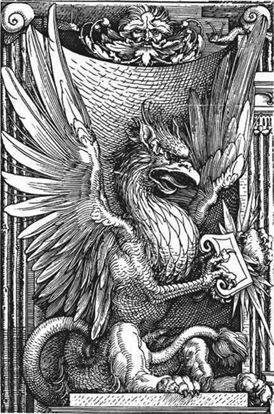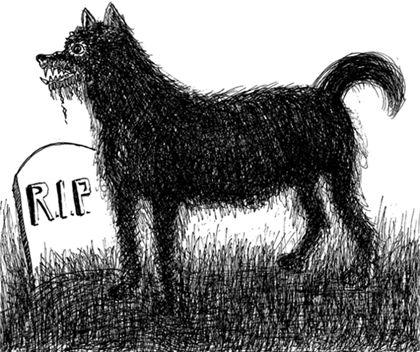The Sorcerer's Companion: A Guide to the Magical World of Harry Potter (35 page)
Read The Sorcerer's Companion: A Guide to the Magical World of Harry Potter Online
Authors: Allan Zola Kronzek,Elizabeth Kronzek


 f all magical creatures, few have been imagined in such starkly opposing ways as the griffin—father of the noble
f all magical creatures, few have been imagined in such starkly opposing ways as the griffin—father of the noble
hippogriff
. A hybrid monster joining the head, wings, and talons of an eagle with the body of a lion, the griffin has sometimes been regarded as regal and brave, other times as vicious and greedy, and either saintly or satanic depending on the source.
Griffins (from the Greek
gypos
, meaning “hooked,” and the Persian
giriften
, meaning “to grip”) appear in drawings and carvings dating back at least 5,000 years. The oldest images are found in sanctuaries and tombs in Egypt and Persia, suggesting that the griffin may have originally been a type of guardian spirit. The Greek traveler and poet Aristeas, who wrote around 675
B.C.
, was the first to describe the creature’s habitat and behavior. Relating stories that had been told to him by the nomads of Eurasia, Aristeas reported that griffins were fierce, gold-hoarding creatures that lived in the deserts and mountains of Mongolia. Their nests, made of pure gold, were located high in the mountains, affording the creatures an excellent view of the vistas below. Ferociously protective of their treasure and their young, griffins were said to swoop down and carry off in their huge talons (or sometimes in their lion’s claws) any human that dared encroach upon their territory. In later stories, they also had a taste for the flesh of horses.
As in the case of the
basilisk
or
unicorn
, the legendary griffin may have been based on a real animal. One candidate is the lammergeier, an enormous vulture that inhabits the mountains of Europe and Asia and carries off live prey. Another theory suggests that griffin legends arose as a way of explaining the fossil remains of mysterious, hook-beaked creatures that were found in profusion in the gold-rich areas of the Gobi Desert, exactly where the stories of the gold-loving griffin originated. We now know the creature to be the Protoceratops, a six-foot-long dinosaur with a parrot-like beak and a crest around the neck that could have been mistaken for wings.

Whatever the source of the legend, after Aristeas told his tale, griffins enlivened the imaginations of Greek and Roman artists. The creatures were shown attacking
stags
and horses, or hitched to the chariots of the gods, transporting Apollo, Zeus, and Nemesis (the goddess of vengeance) through the heavens. During the Middle Ages, griffins came to symbolize both good and evil. The Italian poet Dante Alighieri (1265–1321) made the griffin into a symbol of Christ because of the beast’s mastery of both heaven and earth. At the same time, other writers characterized the griffin as a
demon
.
The combination of the lion’s regal strength and nobility with the eagle’s swiftness and vision also made the griffin a perfect icon for heraldry. It was emblazoned on the shields of knights and on royal crests and coats of arms. Griffins can also be found in Gryffindor House (named after Godric Gryffindor, whose name means “golden griffin”), as a brass knocker on the door to Albus Dumbledore’s office, and near the girls’ bathroom where the Mountain
Troll
made a famous appearance. These griffins, no doubt, reflect the noblest aspects of this magical beast.


 hen Harry finds himself being followed around by an enormous black dog, he suspects the creature may be a grim, a spirit in the form of a menacing dog that has long been known in the British Isles as an omen of death. Luckily, however, the beast turns out to be none other than Harry’s godfather, Sirius Black, who can conveniently transform himself into a dog at will.
hen Harry finds himself being followed around by an enormous black dog, he suspects the creature may be a grim, a spirit in the form of a menacing dog that has long been known in the British Isles as an omen of death. Luckily, however, the beast turns out to be none other than Harry’s godfather, Sirius Black, who can conveniently transform himself into a dog at will.
Unless there’s a graveyard we don’t know about at Hogwarts, Harry’s fear that a grim was following him was probably unwarranted, for by most accounts grims never leave the churchyards or burial grounds they inhabit. In both British and Scandinavian folklore “grim” can be a general term for a household spirit, but it is more commonly used to refer to the “church grim,” a guardian of dead souls that in England takes the form of a big, shaggy, black dog with
fiery eyes
. In Scandinavia, the church grim may also appear as a horse, lamb, or pig.

According to English tradition, the church grim bears the heavy responsibility of protecting a graveyard from the Devil and
witches
. In the early Christian era, many people believed that when a new churchyard was created the first person buried there would have to guard it against satanic influence. But some also believed that if a pure black dog was buried in the northern part of the churchyard, the animal could stand guard instead, freeing a human soul to go on to the afterlife.
Grims are usually invisible, but during stormy weather they can be seen roaming about the churchyard. They may also appear at midnight on the night before a death, or standing in the church tower during a burial. It is said that the clergyman delivering a funeral service can tell from the grim’s appearance whether the soul of the deceased is destined for heaven or hell.


 ittle does Harry
ittle does Harry
realize
when he first encounters a grindylow—pressing its hideous green face against the glass of the aquarium in Professor Lupin’s office—that this experience will turn out to have a practical use. For these water
demons
of English folklore inhabit the Hogwarts lake, and Harry must face them as part of his second task in pursuit of the Goblet of Fire.